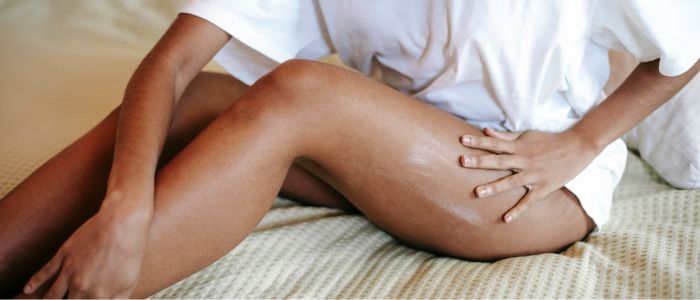
Effective Solutions for Excess Skin Post Weight Loss
The United Kingdom, much like the rest of the world, has been ardently focusing on health and wellbeing. As a nation, we’ve increasingly become aware of the need for a balanced lifestyle, good nutrition, and regular physical activity. It’s heartening to see many of our fellow citizens turning to healthier ways of living, and as a result, shedding excess weight. From health programmes to fitness challenges, the surge towards weight loss has been massive and commendable. However, in this journey, there’s an aspect that often gets overlooked – the challenge of dealing with the excess skin that remains post this significant weight loss.
Anca Breahna is a highly regarded Chester Consultant Plastic Surgeon who specialises in aesthetic and reconstructive plastic surgery, including a range of body contouring procedures.
Download Anca Breahna’s Tummy Tuck Guide

What Is Excess Skin?
At a fundamental level, our skin is a marvel. It’s our body’s largest organ, capable of stretching and contracting. Think of those times when you’ve filled a balloon with air. As the air fills it, the latex stretches. Now, imagine if that balloon were to stay inflated for a very long time and then suddenly deflated. The latex would no longer be taut, and it would have lost its elasticity. This analogy is quite similar to what happens with our skin, especially when it has been stretched for prolonged periods due to excess weight.
Factors influencing excess skin
- Duration of weight gain: Simply put, the longer someone remains overweight, the more their skin stretches. Over time, it can lose its ability to retract completely once the weight is lost
- Skin elasticity: A vital component in this puzzle is collagen. Collagen provides our skin with the elasticity it requires. However, factors such as age, sun exposure, and genetics can reduce its production, thereby affecting skin elasticity
- Amount of weight lost: Not surprisingly, the more weight you lose, the more noticeable the excess skin might be. Those who lose a modest amount might not face this issue as prominently as someone who has undergone a dramatic weight loss journey
Causes of Excess Skin after Weight Loss
Understanding the root causes of excess skin can help set realistic post-weight loss expectations:
- Rapid loss vs. gradual loss: The rate at which you lose weight can significantly affect how your skin reacts. Rapid weight loss might not give the skin sufficient time to adjust, leading to more pronounced sagging. Gradual weight loss, on the other hand, allows the skin more time to adapt to the body’s changing shape
- Age and skin elasticity: Youth does have its advantages. Younger individuals often have skin that’s more elastic. As we grow older, our skin naturally loses some of this elasticity. This means that older individuals, even if they lose weight gradually, might still experience some level of skin sagging
- Genetics: Genetics play a pivotal role in many aspects of our health and appearance, including how our skin responds after weight loss. If your parents or grandparents had tight skin in their later years, chances are, you might too
Non-Surgical Approaches to Managing Excess Skin
The idea of surgery might seem daunting to some. Before making such a significant decision, it’s worth considering non-surgical methods to manage the appearance and texture of excess skin:
- Topical treatments: The market in the UK is brimming with creams and ointments claiming to firm up the skin. While it’s important to be realistic and understand that no topical treatment can achieve the results of surgery, some products can indeed improve skin texture and minor elasticity issues. Ingredients to look out for include retinoids, hyaluronic acid, and peptides. Always remember to patch-test any product and consult with a dermatologist if unsure
- Exercise and its impact: Engaging in regular physical activity, especially strength training, can be beneficial. Building muscle can help fill out the space previously occupied by fat. While this might not drastically reduce excess skin, it can improve the overall appearance and contour of the body. Focusing on compound exercises, like squats, deadlifts, and bench presses, can target large muscle groups, potentially tightening the appearance of nearby skin
- Massage and therapies: Regular massage might improve blood circulation and stimulate the production of collagen and elastin, both crucial for skin elasticity. Some also vouch for therapies like dry brushing to enhance skin appearance, although concrete scientific evidence on its efficacy remains limited
- Stay hydrated: Drinking plenty of water maintains skin hydration, which, in turn, can improve its appearance. Well-hydrated skin can look plumper and more radiant
Remember, while these methods can provide some improvement, expectations should be kept realistic. They won’t offer the same results as surgical interventions.
Surgical Solutions for Excess Skin
When considering solutions for excess skin following weight loss, it’s important to acknowledge that sometimes, non-surgical methods might not offer the comprehensive results you’re looking for. Surgical procedures, while a more significant step, often provide clearer, lasting outcomes.
Abdominoplasty (Tummy Tuck)
An abdominoplasty, more commonly known as a tummy tuck, is designed to address excess skin in the abdominal area. Here’s what to expect:
- Procedure: Anca will make an incision, usually from hip to hip, just above the pubic area. Through this incision, the surplus skin is removed, and often the underlying abdominal muscles are tightened. The remaining skin is then pulled down and sutured in place, giving a firmer and smoother appearance
- Recovery: Recovery times can vary, but you’ll need to take it easy for a few weeks. This means avoiding heavy lifting and strenuous exercise. Always follow Anca’s advice for the best and safest recovery
- Results: You will notice a significant improvement in the contour of their abdomen. Remember, though, that results can vary depending on individual factors like age, genetics, and overall health
Arm Lift and Thigh Lift
Fluctuating weight can often leave the arms and thighs with sagging skin. Arm lift (brachioplasty) and thigh lift can be beneficial in these cases.
- Procedure: For an arm lift, an incision is made either on the inside or back of the arm, depending on the technique used and the amount of skin to be removed. For a thigh lift, incisions vary based on the area being treated, be it the inner thigh, outer thigh, or both
- Recovery: Just as with a tummy tuck, recovery involves rest. Avoid putting unnecessary strain on the treated areas and adhere to post-operative care instructions provided by Anca’s team
- Results: The goal is a more toned appearance. While the difference is usually noticeable, remember that healing also plays a role in the final outcome
Lower Body Lift
A comprehensive solution, the lower body lift addresses multiple areas in one procedure, making it a popular choice for those who’ve undergone significant weight loss.
- Procedure: Incisions are made around the belt-line, extending towards the thighs and buttocks. Excess skin is removed, and the remaining skin is lifted and tightened
- Recovery: As this is a more extensive procedure, recovery might be a bit longer compared to the other surgeries. It’s essential to give your body the time it needs to heal and avoid activities that might hinder the recovery process
- Results: A lower body lift can offer a significant change, enhancing the appearance of the abdomen, thighs, and buttocks
Pros and Cons of Surgical and Non-Surgical Treatments
When facing the challenge of excess skin after weight loss, you have a range of options to consider, both surgical and non-surgical. Making an informed choice is essential, and to assist you in this decision-making process, we’ve outlined the pros and cons of each approach.
Pros for Non-Surgical Treatments
- Less Invasive: One of the main benefits of non-surgical treatments is that they are less invasive than surgical options. There’s no need for incisions, anaesthesia, or extended recovery periods
- Quicker Recovery: Most non-surgical treatments require little to no downtime. You can often resume your daily activities immediately or within a short period
- Cost: Generally, non-surgical treatments tend to be more affordable than surgical interventions, especially when considering the total costs involved in surgery, such as hospital stays and post-operative care
- Flexibility: You can often try various non-surgical treatments without long-term commitment, allowing you to see which methods work best for you
Cons for Non-Surgical Treatments
- Temporary Results: Non-surgical treatments often offer temporary results, requiring maintenance and repeated sessions to maintain the effects
- Subtle Changes: The improvements from non-surgical treatments are more subtle than what surgical options can offer
- Variability: Results can vary significantly from person to person based on individual skin conditions, making outcomes less predictable
Pros for Surgical Treatments
- Long-lasting Results: Once the excess skin is removed through surgery, the results are generally permanent, provided you maintain a stable weight
- Dramatic Improvements: Surgical interventions can offer transformative changes, especially for those with a significant amount of excess skin
- Tailored Procedures: Surgeries can be customised to address specific areas of concern, allowing for more targeted results
Cons for Surgical Treatments
- Recovery Time: Surgery requires a recovery period, during which you might need to take time off work and avoid certain activities. Recovery can range from a few weeks to a few months, depending on the procedure
- Cost: Surgical solutions tend to be more expensive up front. While they might offer long-term benefits, the initial outlay can be significant
- Potential Risks: All surgeries come with inherent risks, including complications from anaesthesia, infections, scarring, or unsatisfactory results
- Scarring: Even though surgical techniques have advanced and Anca aims to place incisions in less visible areas, scarring is still a consideration
FAQS about Excess Skin After Weight Loss
Why do I have excess skin after losing weight?
- Excess skin after weight loss is common, especially if the weight loss was rapid. Your skin is elastic, but when it’s stretched over a long period due to weight gain, it might not be able to return to its original shape once the weight is lost. Factors like age, genetics, the amount of weight lost, and how quickly it was lost can all impact skin elasticity.
How long should I wait after weight loss before considering skin removal surgery?
- It’s recommended to wait until your weight has stabilised for at least 6-12 months. This allows your body to adjust, and it ensures that any surgical improvements will be long-lasting. It’s also crucial to be in good health and ideally at your target weight before undergoing surgery.
Are the results from skin removal surgery permanent?
- The removal of excess skin is permanent. However, future weight fluctuations, ageing, and other factors can alter your body’s appearance over time. Maintaining a stable weight and a healthy lifestyle can help prolong the results.
Can exercises or toning help reduce excess skin?
- While exercise, especially strength training, can help improve muscle tone underneath the skin, it can’t eliminate significant amounts of excess skin. However, building muscle can enhance the body’s overall contour and appearance, making excess skin less noticeable.
What are the potential side effects of non-surgical treatments for excess skin?
- Side effects vary depending on the specific treatment. Generally, non-surgical methods might lead to temporary redness, swelling, or minor discomfort. It’s essential to consult with a professional before undergoing any treatment to understand potential side effects and their likelihood.
Further Reading about Surgical Solutions after for Excess Skin after Weight Loss
- Read more about What is a Tummy Tuck Procedure?
- Read more about What is a Mummy Makeover?
- Read more about Is Abdominoplasty Major Surgery?
- Read more about Breasts after Weight Loss
- Read more about How Much Weight Can You Lose With A Tummy Tuck?
- Read more about Liposuction vs Tummy Tuck
- Read more about Arm Lift or Arm Liposuction
- Read more about How to Get Rid of Excess Fat & Skin – Treatment Options
- Read more about How to Get Rid of an Apron Belly
Medical References about Surgical Solutions for Excess Skin after Weight Loss
- You Lost the Weight. What About That Extra Skin? – WebMD
- Aspects Of Excess Skin in Obesity, After Weight Loss – Science Direct
- Excess Skin Removal: What It Is, Surgery, Procedures – Cleveland Clinic
- Skin Protein Profile after Major Weight Loss and Its Role in Body Contouring Surgery – NCBI



 Ms Anca Breahna, PhD, MSc, FEBOPRAS, FRCS (Plast) is a highly regarded Consultant Plastic Surgeon specialising in the field of Aesthetic and Reconstructive Plastic Surgery. Anca performs a range of
Ms Anca Breahna, PhD, MSc, FEBOPRAS, FRCS (Plast) is a highly regarded Consultant Plastic Surgeon specialising in the field of Aesthetic and Reconstructive Plastic Surgery. Anca performs a range of 